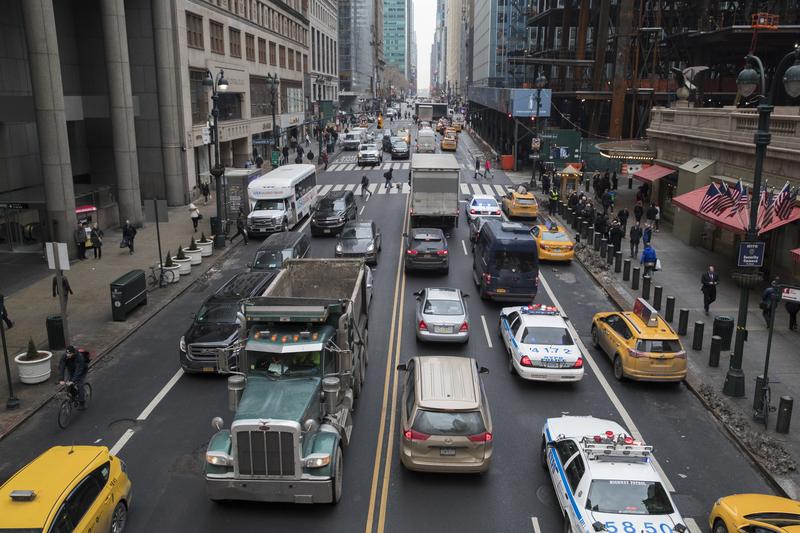
A new plan commissioned by New York Gov. Andrew Cuomo recommends a series of actions to reduce congestion in Manhattan and create a dedicated revenue stream for the MTA. Under one scenario, drivers would pay $11.52 to drive into the busiest parts of Manhattan.
Trucks would pay even more — $25.34 — while taxi cabs, Uber rides and for-hire vehicles would be charged between $2 and $5 per ride. The pricing zone would cover Manhattan south of 60th Street.
All in all, the plan would result in modest gains both for the MTA and Manhattan's traffic speeds. The revenues, estimated at between $955 million and $1.4 billion a year, would amount to a roughly 5 percent boost in funding for the MTA, which spends about $21 billion a year on operations and capital improvements. Midtown speeds are expected to increase about 9 percent, according to the report, which would be almost imperceptible (from the current 6.8 miles an hour to 7.4 miles an hour).
"It just seems that there was not a whole of creativity that was involved in putting together this report," said Robert Sinclair, Jr., a spokesman for AAA. "It's supposed to reduce congestion. It doesn't seem like it would do that."
But members of the task force that wrote the report insist that some progress is better than none.
"There are going to be some naysayers," said former Bronx Borough President Freddy Ferrer, an MTA board member. "It's clear that the status quo is no longer acceptable."
A similar plan in 2008 proposed by Mayor Bloomberg died when the legislature in Albany never even took a vote on it after some lawmakers portrayed it as a burden on the poor and middle class. But since then, subway service has seriously deteriorated, and the staunchest opponent in the state Assembly, then-Speaker Sheldon Silver, was indicted and removed from office.
In the past, Mayor De Blasio has spoken out against congestion pricing, but he met the latest report more warmly, calling it a "step in the right direction." He said he wants a guarantee that revenue from the surcharge will go toward public transportation.
"We need to know a lot more," he said on WNYC's Brian Lehrer Show Friday. "What we still don't see is money ... being put in a lock box that would only fund transit in New York City."
London and Singapore already have similar congestion surcharges in place. But in London, which introduced congestion pricing over 15 years ago, traffic speeds have gotten worse after an initial improvement. In part, that's a reflection of the system's success there: the money raised for mass transit has been spend on dedicated bus and bike lanes, as well as more pedestrian walkways, which have interfered with driving. The British capital also has its own problem with ride-sharing services like Uber, which has clogged streets with additional vehicles looking to pick up rides.
Yasmin Sohrawardy, who drives from Queens into Manhattan twice a week for her job as a financial software developer, opposes any proposal to charge drivers.
"The people in the outer boroughs, who don't have access to public transportation the way people do in Manhattan, can't possibly afford this," said Sohrawardy, 47. "It's going to be extraordinarily expensive. If you live in Manhattan, you can take subways, buses or taxis."
The fees on taxis and for-hire vehicles could take effect within a year, followed by trucks and then cars in 2020, according to the report. The task force said that the MTA should front-load transit improvements, particularly in outer boroughs, first, before the fees are implemented.
The congestion pricing task force was created by Cuomo last year after he declared a state of emergency in the subways.
It's reasonable to charge motorists more to drive into Manhattan, according to Nick Sifuentes, executive director of the Tri-State Transportation Campaign, since travelers using the subway, buses, ferries and trains already pay a fare to reach Manhattan.
"The only folks who don't pay at all are drivers — and those cars are clogging our streets, polluting our air, and harming the economy," he said. "If you choose to drive into the most transit-rich neighborhoods in the United States, it's only fair that you also pay your fair share too."
